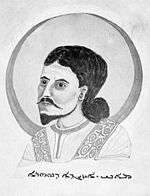Cao'an
Cao'an (Chinese: 草庵; pinyin: Cǎo'ān; Pe̍h-ōe-jī: Chháu-am; lit.: 'thatched nunnery'[1]) is a temple in Jinjiang, Fujian. Originally constructed by Chinese Manicheans, it was considered by later worshipers as a Buddhist temple. This "Manichean temple in Buddhist disguise"[2] is seen by modern experts on Manichaeism as "the only extant Manichean temple in China",[3] or "the only Manichean building which has survived intact".[4]
| Cao'an | |
|---|---|
草庵 | |
.jpg) | |
| Religion | |
| Affiliation | Manichaeism |
| Province | Fujian |
| Deity | Buddha of Light (Mani) |
| Location | |
| Country | China |
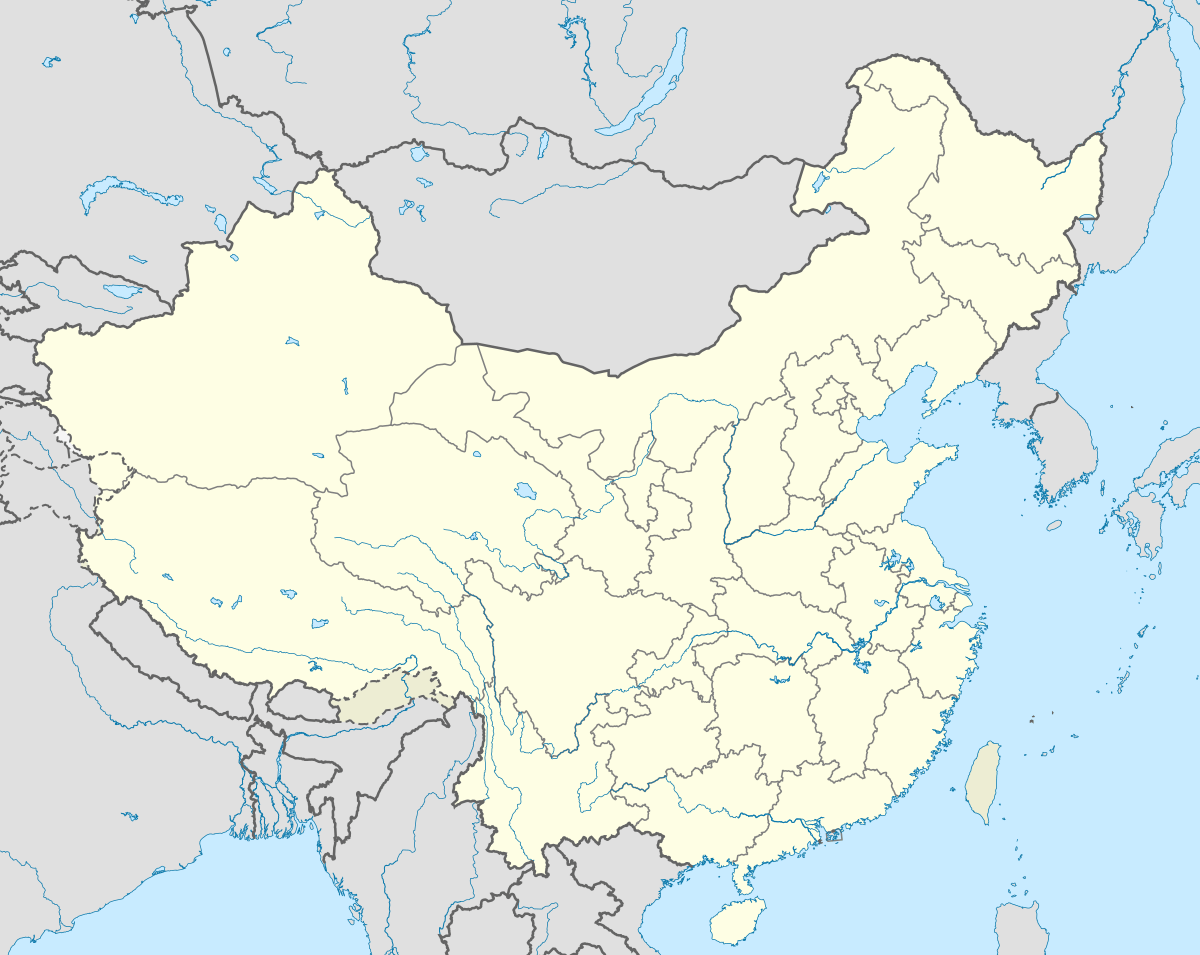 Shown within China | |
| Geographic coordinates | |
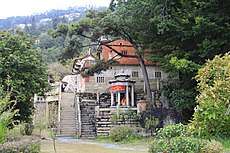
Geography
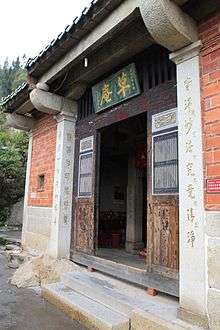
The temple is located on the southern slope of Huabiao Hill near Shedian Village just west of downtown Jinjiang.[5][6] Jinjiang is part of Quanzhou, which was known historically as "Quanzhou Prefecture"; the location is some 50 kilometres (31 mi) south of downtown Quanzhou.[4]
He Qiaoyuan (1558-1632) explained in his local history, the Book of Fujian (Chinese: 闽书; pinyin: Mǐnshū), that Huabiao Hill's name comes from the fact that it and the nearby Lingyuan Hill, look like a pair of huabiao.[7]
The temple as it exists today is not too different from a typical Buddhist temple of its region. It is a two-story granite building with the worship space downstairs and living space for a few priests upstairs.[8]
Background: Manichaeism in Fujian
Manichaeism arrived in China in 694 or earlier during the Tang dynasty (618-907). Early on, the Manichaean religion was strongly associated with Sogdian merchants, and, later, with Uyghurs resident in the Tang state. The religion was, however, primarily present in northern and central China (the Yangtze region) and suffered a strong setback during the anti-Manichaean campaign of 843, the prelude to the Great Anti-Buddhist Persecution of 845, when foreign Manichaean priests were exiled or executed.[9]
It was in the 10th century, after the fall of the Tang, that Manichaeism, now primarily practised by Han Chinese, reached Fujian. Its arrival in the province is linked to a certain Manichaean preacher who fled to Fujian from persecutions in North China, traveled extensively throughout the province, and eventually died and was buried in Quanzhou Prefecture,[10] which thus became one of the centers of Chinese Manichaeism during the Song dynasty.[11]
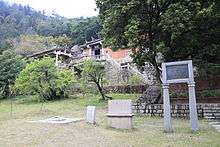
Manichaeism in China assumed certain Chinese characteristics, assimilating to both Buddhism and Taoism.[12] Chinese translations of Manichaean treatises were couched in Buddhist phraseology,[13] and the religion's founder (Mar) Mani (known in China as (末)摩尼, (Mo)-Mani) received the title of the "Buddha of Light" (Chinese: 光明佛 or 光佛), and a life story resembling that of Gautama Buddha.[14] At the same time, the Taoist (or pseudo-Taoist?) treatise, the Huahujing "Scripture of the Conversion of the Barbarians", popular with Chinese Manichaeans, declared Mani to be a reincarnation of Laozi.[15] As to the Confucian civil authorities of the Song state, when the clandestine cells of Mani's followers came to their attention, they were usually lumped together with assorted other suspicious and potentially troublesome sects as "vegetarian demon worshipers" (Chinese: 吃菜事魔).[16]
Not surprisingly, such Manichaean temples as were erected in Song China usually had an official Buddhist or Taoist affiliation.[17] There are records, for example, of a Manichaean temple in Taoist disguise at Siming. This temple - one of the northernmost known Manichaean sites of the Song era - was established in the 960s, and was still active - in a more standard Taoist way, but with a memory of Manichaeism retained - in the 1260s.[18]
History

The temple is said to have been initially constructed during the reign of Emperor Gaozong of Song, the first emperor of the Southern Song (mid-12th century), as a straw hut. It was rebuilt in a more permanent way in the 5th year of the Zhiyuan era of Toghon Temür of the Yuan dynasty (1339).
Manichaeism in China became gradually extinct during the Ming and practically forgotten by the close of the Ming period; little material is available on the last centuries of the religion's existence. A short poem by Huang Fengxiang (d. 1614) tells about his visit to Cao'an Temple, which at the time had already been abandoned. The poet mentions Buddhist and Taoist symbols, but shows no awareness on its author's part of the temple's Manichaean origin.[19]
The Quanzhou historian He Qiaoyuan left a short account of the shrine on Huabiao Hill and its Manichaean origin in the Book of Fujian, which also gave him a reason to summarize what little he knew about the Manichaeans. This text is one of the few pieces of literary evidence we have from the last centuries of Manichaeism in China.[20] He Qiaoyuan speculated that there were still some followers of the "Religion of Light" (Chinese: 明教) in Fujian in his days, but they "[were] not much in evidence" ("不甚显云").[20][21]
Cao'an was renovated in 1922, becoming an annex of a Buddhist temple complex where the "ancestral teachers of India and China" were venerated; however, that temple complex later fell into disuse as well.[22] As Samuel N.C. Lieu notes, worshipers at the time would probably think that the "Moni" moniker in Cao'an inscriptions referred to "[Śākya]muni" ([释迦]牟尼), i.e. Gautama Buddha;[22] this is what the locals told archaeologist Wu Wenliang a few years later as well.[23]
After He Qiaoyuan's account of the Manichaean shrine was brought to the attention of modern scholars in 1923, by Chen Yuan (陈垣) and Paul Pelliot,[24] local researchers started looking for it. After a long search by a number of researchers (frustrated, at one point, by the presence of marauding bandits[1]), it was finally identified with the existing building by the Quanzhou archaeologist Wu Wenliang (吴文良) in 1940,[25] who presented the results of his on-site research in a 1957 publication.[23]
In 1961, the temple was entered on the Fujian provincial list of protected cultural monuments; in 1996, it was added to China's National List of Historical and Cultural Sites, Fujian.[5]
Statuary and inscriptions
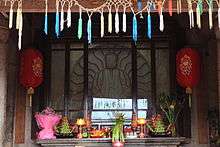
The most remarkable Manichaean relic in the temple is the statue of Manichaeism's founder Mani, commonly referred to in the Chinese Manichaean tradition as the "Buddha of Light". According to an inscription, the statue was donated to the temple by a local adherent in 1339.
While the statue may look like any other Buddha to a casual observer, experts note a number of peculiarities which distinguish it from a typical portrayal of the Buddha. Instead of being curly-haired and clean-shaven, as most other Buddha statues, this Buddha of Light is depicted having straight hair draped over his shoulders, and sporting a beard. The facial features of the prophet (arched eyebrows, fleshy jowls) are somewhat different from a traditional Chinese stone Buddha as well.[4] It is even said that the stone Mani the Buddha of Light used to have a mustache or sideburns, but they were removed by a 20th-century Buddhist monk, trying to make the statue more like a traditional Buddha.[1]
Instead of looking down, as Buddha statues usually do, the Mani statue looks straight at the worshipers. Instead of being held in a typical Buddhist mudrā, Mani's hands rest on his belly, with both palms facing upward.[4]
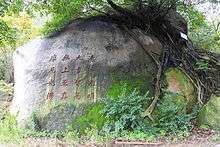
In order to give the statue an overall luminous impression, the sculptor carved its head, body, and hands from stones of different hues.[4]
Instead of a nianfo phrase, universally seen in China's Buddhist temples,[23] an inscription on a stone in the courtyard dated 1445 urges the faithful to remember "Purity (清净), Light (光明), Power (大力), and Wisdom (智慧)", which are the four attributes of the Father of Light,[4] one of the chief figures of the Manichaean pantheon.[26] These four words (eight Chinese characters) were apparently an important motto of Chinese Manichaeism; it is described as such in an anti-Manichean work by the Fujianese Taoist Bo Yuchan (real name Ge Changgeng; fl. 1215).[27] The original inscription was destroyed during the Cultural Revolution, but later "restored" (apparently, on another rock).[1]
Notes
- Samuel N.C. Lieu and Ken Parry, Manichaean and (Nestorian) Christian Remains in Zayton (Quanzhou, South China). ARC DP0557098 Archived 2014-08-08 at the Wayback Machine
- Werner Sundermann, MANICHEISM i. GENERAL SURVEY at Encyclopædia Iranica
- Samuel N.C. Lieu, CHINESE TURKESTAN: vii. Manicheism in Chinese Turkestan and China at Encyclopædia Iranica
- Lieu 1992, pp. 256–257
- Li Yukun (李玉昆) 福建晋江草庵摩尼教遗址 (The relics of Manichaean temple Cao'an in Jinjiang, Fujian), 2006
- Google Maps
- Lieu 1998, p. 194
- Pearson, Li & Li 2002, pp. 38–40, based on Lieu 1980, pp. 80–82
- Lieu 1992, pp. 231–239,263
- Lieu 1992, p. 264
- Lieu 1992, p. 267
- Mair 1987, p. 316
- Mair 1987, pp. 317–318
- Lieu 1992, pp. 243,255–257
- Lieu 1992, pp. 258–259.
- Lieu 1992, pp. 280–283,298
- Lieu 1992, pp. 268
- Lieu 1992, pp. 268,292–294
- Lieu 1992, p. 303
- Lieu 1992, p. 301
- The original text of the relevant section of Min Shu, French translation, and detailed comments, can be found in Pelliot 1923, pp. 198–207; English translation, in Lieu 1998, pp. 194–195
- Lieu 1992, p. 304
- Lieu 1980, pp. 80–82
- Pelliot 1923, p. 198
- Lieu 1992, p. 304; Guo Zhichao (郭志超); the 1940 date is from 作为民间信仰的摩尼教 — 晋江草庵附近村社的摩尼教变异遗存, 2007-08-26
- Lieu 1998, p. 136
- Lieu 1992, pp. 291–292
References
| Wikimedia Commons has media related to Cao'an. |
- Lieu, Samuel N. C. (1992), Manichaeism in the Later Roman Empire and Medieval China, Volume 63 of Wissenschaftliche Untersuchungen Zum Neuen Testament (2 ed.), Mohr Siebeck, ISBN 3161458206
- Lieu, Samuel N. C. (1998), Manichaeism in Central Asia and China, Volume 45 of Nag Hammadi and Manichaean Studies, Brill, ISBN 9004104054
- Lieu, Samuel N. C. (Mar 1980), "Nestorians and Manichaeans on the South China Coast", Vigiliae Christianae, 34 (1), pp. 71–88, JSTOR 1582860
- Mair, Victor H. (1987), "(Review of) Manichaeism in the Later Roman Empire and Medieval China: A Historical Survey by Samuel N. C. Lieu; The Chinese Transformation of Manichaeism: A Study of Chinese Manichaean Terminology by Peter Bryder", T'oung Pao, 73 (4/5): 313–324, JSTOR 4528393
- Pelliot, Paul (July 1923), "Les traditions manichéennes au Fou-kien", T'oung Pao, Second Series, 22 (3): 193–208, doi:10.1163/156853223x00122, JSTOR 4526697
- Pearson, Richard; Li, Min; Li, Guo (March 2002), "Quanzhou Archaeology: A Brief Review", International Journal of Historical Archaeology, 6 (1): 23–59, JSTOR 20852986
